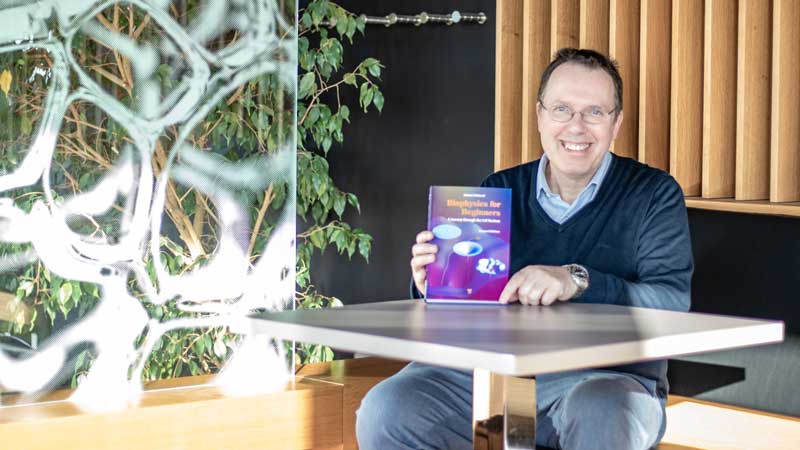Unique textbook teaches physics of biomolecules
How can physics and biology be brought together to understand living matter? With his textbook, Professor Schießel aims to achieve this goal. Bringing the two disciplines together opens a new window to understanding living processes - the physics of life. To approach the complex questions of biophysics, the textbook focuses on the processes in the cell nucleus, e.g., how many layers of information carries DNA in addition to classical genetic information, and how all this can be passed on to the next cell generation.
As a scientist, Schießel has been working on the biophysical processes in the cell nucleus for 20 years. Since 2021, he leads the research group Theoretical Physics of Living Matter group at the Cluster of Excellence Physics of Life (PoL) at TU Dresden, of which he is the deputy director at the same time. His deep understanding of the biological physics inside the cell nucleus and of the biomolecules, resulted in the book “Biophysics for Beginners: A Journey Through the Cell Nucleus”, which was published by Jenny Stanford Publishing in November 2021 in the second edition.
By focusing thematically on processes in the cell nucleus, Professor Schießel has succeeded in delivering a book that does not require any prior specialized knowledge of mathematics, physics, or molecular biology, and yet reaches to cutting-edge research questions and, along the way, conveys knowledge of bioinformatics in an easy way. “Going into depth, rather than breadth, is my teaching philosophy, which is also reflected in the style of the book. In my opinion, with a topic as broad as biological physics, it makes sense to take readers successively into the depths of the questions to get to the bottom of the interplay in an understandable way. This way, readers learn to really elicit things, examine them, and see the connections. No other book seems to be able to do that to a similar extent,” explains Helmut Schießel.
Hence, the book is suitable for students of physics and biology, as well as for researchers who would like to gain further training in biophysics. In this context, Schießel’s new edition plays a fundamental role: as an in-house textbook for the new master’s program “Physics of Life” at the TU Dresden. The two-year, interdisciplinary program will launch for the first time in fall 2022. “Above all, I really like to get students enthused about the exciting subject of biophysics, give them an overview of the most important scientific topics, and describe complex processes using practical case studies,” describes Schießel.
The cell nucleus, with its complex structure and function to store and pass on genetic information, provides the perfect setting to introduce students to many cutting-edge research questions, such as the biomolecular condensates discovered in Dresden. These are formed by a physical phenomenon in which molecules gather in droplets inside the cell, much like oil droplets in water. In order to understand this phenomenon, and to explore, for which – so far unexplained – cell functions the droplets are required for, the interdisciplinary approach of biophysics is needed. The new research results in this field open up promising prospects for the development of therapies, e.g. of neurodegenerative diseases such as dementia. Therefore, it is an important matter of concern for Professor Schießel to communicate these topics to the next generation of scientists.
About the author:
Helmut Schießel earned his PhD in Theoretical Polymer Physics at the Albert Ludwigs University in Freiburg, Germany, in 1997. Afterwards he worked as a postdoc at the University of California, Santa Barbara Barbara (UCSB), USA. Then, he was a joint postdoc with Profs. W. M. Gelbart and R. Bruinsma at the University of California, Los Angeles. In 2000, he joined the Theory Group of the Max Planck Institute for Polymer Research, Mainz, Germany, where he was in charge of a biophysics research project. From 2005 to 2020, Prof. Schießel headed the chair of Theoretical Physics of Life Processes in the Instituut-Lorentz at Leiden University, the Netherlands. Since 2021, he leads the Theoretical Physics of Living Matter group of the Cluster of Excellence Physics of Life at the Technische Universität Dresden, Germany.
Biophysics for Beginners: A Journey Through the Cell Nucleus
Author: Helmut Schießel
Publisher: Jenny Stanford Publishing; 2nd Edition (November 18, 2021)
Language: English
Hardcover edition: 513 pages
ISBN-10: 9814877808
Price hardback book: 144 €
Available at: https://www.amazon.de/Biophysics-Beginners-Journey-Through-Nucleus
Reviews: https://www.jennystanford.com/9789814877800/biophysics-for-beginners-second-edition/
About PoL - Cluster of Excellence Physics of Life
The Cluster of Excellence Physics of Life (PoL) at TU Dresden focuses on identifying the laws of physics that underlie the organization of life into molecules, cells and tissues. At the cluster, physicists, biologists and computer scientists join forces to investigate how active matter organizes itself into predetermined structures in cells and tissues, thus giving rise to life. PoL is funded by the DFG as part of the Excellence Strategy. It is a collaboration between scientists from TU Dresden and research institutions of the DRESDEN-concept network, such as the Max Planck Institute of Molecular Cell Biology and Genetics (MPI-CBG), the Max Planck Institute for the Physics of Complex Systems (MPI-PKS), the Leibniz Institute of Polymer Research (IPF) and the Helmholtz-Zentrum Dresden-Rossendorf (HZDR). www.physics-of-life.tu-dresden.de
Further information:
Prof. Dr. Helmut Schießel
Phone: +49 351 463-41253
Email: helmut.schiessel@tu-dresden.de
Media contact PoL:
Bianka Claus
DFG Cluster of Excellence Physics of Life (PoL), TU Dresden
Public relations
Phone: +49 351 463-40133
Email: bianka.claus@tu-dresden.de
